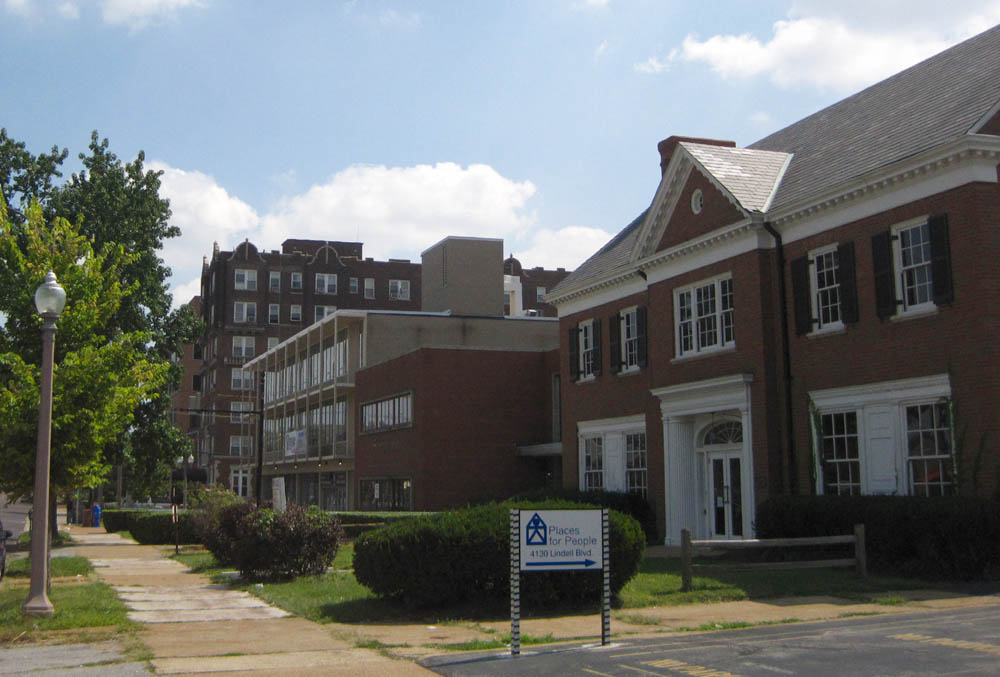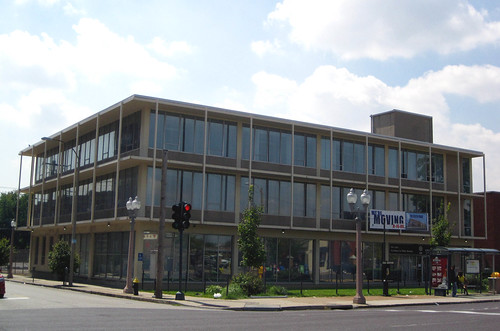 Here is the site at Lindell and Sarah avenues in the Central West End that discount and drug store giant CVS is targeting for a new store. The site encompasses two historic buildings from our recent past that would be obliterated for a low-density big-box store with a drive through lane. Domino effect is evident: Walgreens is just a block west on a site where the mid-century Cinerama fell for the chain-store box. CVS wants to follow suit, but its aim is at a prominent corner, and three buildings with higher merit and reuse potential than a movie theater.
Here is the site at Lindell and Sarah avenues in the Central West End that discount and drug store giant CVS is targeting for a new store. The site encompasses two historic buildings from our recent past that would be obliterated for a low-density big-box store with a drive through lane. Domino effect is evident: Walgreens is just a block west on a site where the mid-century Cinerama fell for the chain-store box. CVS wants to follow suit, but its aim is at a prominent corner, and three buildings with higher merit and reuse potential than a movie theater.There seems to be major concern about the design on the part of the West Pine/Laclede Neighborhood Association, whose boundaries encompass the sites. Earlier, the neighborhood group was opposed based on a terrible site plan that CVS has since replaced. This month, the group voted to continue discussions.
At stake is the fate of two buildings whose individual densities are separately greater than the single building that will replace all three. While not completed, the forthcoming Central West End Sustainable Development Plan will likely include provisions discouraging the development of low-density uses on major neighborhood streets like Lindell. Thus, preservation is aligned here with larger planning goals.
 The building at 4100 Lindell dates to 1956 and is one of the first works by then-new firm Hellmuth Obata and Kassabaum (HOK). Built as the regional office of typewriter giant Sperry-Rand Corporation, the building is most familiar to St. Louisans as the headquarters of the St. Louis Housing Authority. The Housing Authority relocated last month to a new building on Page Boulevard.
The building at 4100 Lindell dates to 1956 and is one of the first works by then-new firm Hellmuth Obata and Kassabaum (HOK). Built as the regional office of typewriter giant Sperry-Rand Corporation, the building is most familiar to St. Louisans as the headquarters of the St. Louis Housing Authority. The Housing Authority relocated last month to a new building on Page Boulevard. The Housing Authority building definitely has individual architectural significance. As an early work of HOK, the building is a key part of the development of a body of work that has international significance. The building itself is a fine essay in minimalism. This city has few true examples of modern "glass boxes" and this is one of them. The International Style roots are evident in the ample glazing, neutral colors, and the vertical I-beams that frame the recessed windows. This is a class act, and a fine corner anchor.
 To the west, at 4108 Lindell, is a modest modern work. Built in 1960 for the St. Louis Society for Crippled Children (think Easter Seal), this building is a fine supporting player in the mid-century carnival on Lindell Boulevard. There are 30 modern movement buildings on Lindell between Grand and Kingshighway out of 32 built between 1941 and 1977. Not all of these buildings are tied to great architects or original expressions, but all are integral to an overall composition unlike any other in the city. Where else do we have such abundant mid-century architecture interspersed with the high-style architecture of the Gilded Age and early 20th century? Alas, our decision-makers are just a generation too close to the birth of these buildings to appreciate their significance.
To the west, at 4108 Lindell, is a modest modern work. Built in 1960 for the St. Louis Society for Crippled Children (think Easter Seal), this building is a fine supporting player in the mid-century carnival on Lindell Boulevard. There are 30 modern movement buildings on Lindell between Grand and Kingshighway out of 32 built between 1941 and 1977. Not all of these buildings are tied to great architects or original expressions, but all are integral to an overall composition unlike any other in the city. Where else do we have such abundant mid-century architecture interspersed with the high-style architecture of the Gilded Age and early 20th century? Alas, our decision-makers are just a generation too close to the birth of these buildings to appreciate their significance.  To the west sits a for-sale building that might be more conventionally assumed to be "historic." However, the Colonial Revival office building that once housed Places for People has more in common with its forward-looking neighbors than Independence Hall -- this building dates to 1948 and is part of the wave of new construction on Lindell that took place after World War II. Some developers stuck with the tried and true rather than embrace new design. Either way, the results are splendid.
To the west sits a for-sale building that might be more conventionally assumed to be "historic." However, the Colonial Revival office building that once housed Places for People has more in common with its forward-looking neighbors than Independence Hall -- this building dates to 1948 and is part of the wave of new construction on Lindell that took place after World War II. Some developers stuck with the tried and true rather than embrace new design. Either way, the results are splendid. Today, we are the stewards of this development. The significance of the modern buildings is just starting to be explored by historians. Yet the contrast between the recent demolition of the San Luis Apartments and $9 million rehabilitation of the Hotel Indigo show the divergent paths of owners of these buildings. Perhaps architectural significance will be better appreciated by future generations, but even today we see that these buildings are much better for the urban street scape and Central West End planning goals than a drug store box.





4 comments:
It's imperative that the public shows up for any and every future meeting regarding this proposal and stand up for our built environment. I can't believe we are continuing to see this crap play out over and over and over again. The year is 2009- we must have higher standards for our city.
I understand that it isn't as purely economical to approach and retrofit existing buildings than it is to just demolish & replace with a standard design, but in dense, more "urban" cities it happens all the time in order to get what is typically a "box" store into a neighborhood. Why can't we do that here? And if the developer or corporation doesn't want to, it's not like they are indispensable - indeed, there's a Walgreen's just down the street, so it's not like the neighborhood really suffers.
The redevelopment is a bargain between the sellers of the real estate and the buyer/new user.
What teeth will the proposed planning guide have?
Would the city adopt it as a master plan that all new developments must follow, or will it merely be "advisory" (thus toothless)?
I hate CVS and they generally suck, but on the East Coast they have a sort of decent record of reuse of existing property in dense urban areas.
perhaps a direct lobby to them would help.
Post a Comment